If you told me back in early 2009 that by 2014 my favorite way to enjoy music would be through headphones, I would’ve said you were insane. I was brought up in the high end audio, two-channel in-room stereo world. It all started when I began working for Harry Pearson at The Absolute Sound magazine. Eventually I left TAS to work for Arif Mardin (Grammy-Award winning Producer/arranger/composer) at Atlantic Records, where all the music listening was done through in-room stereo systems. I loved (and still do) listening to my stereo gear. I’ve experienced amazing sonic feats with in-room systems, experiences so profound I thought I’d never hear anything like that again, especially in my home! When I think about it, my first real job was, essentially, as Harry Pearson’s Set-Up and Acquisitions Manager, playing with the bleeding edge of consumer-level stereo electronics for the home (known for being at the high-end of the audio arts). All that at the ripe age of nineteen!
When I went onto Atlantic Records, and learned the record making process, I was lucky enough again to experience some of the greatest-sounding analog and digital studio systems available at the time. And even though as a DJ I was using headphones as a tool for beat matching, I never really considered headphones as any means of seriously connecting with the music on an emotional level – not like we felt during live performances, or with the elaborate two-channel systems.
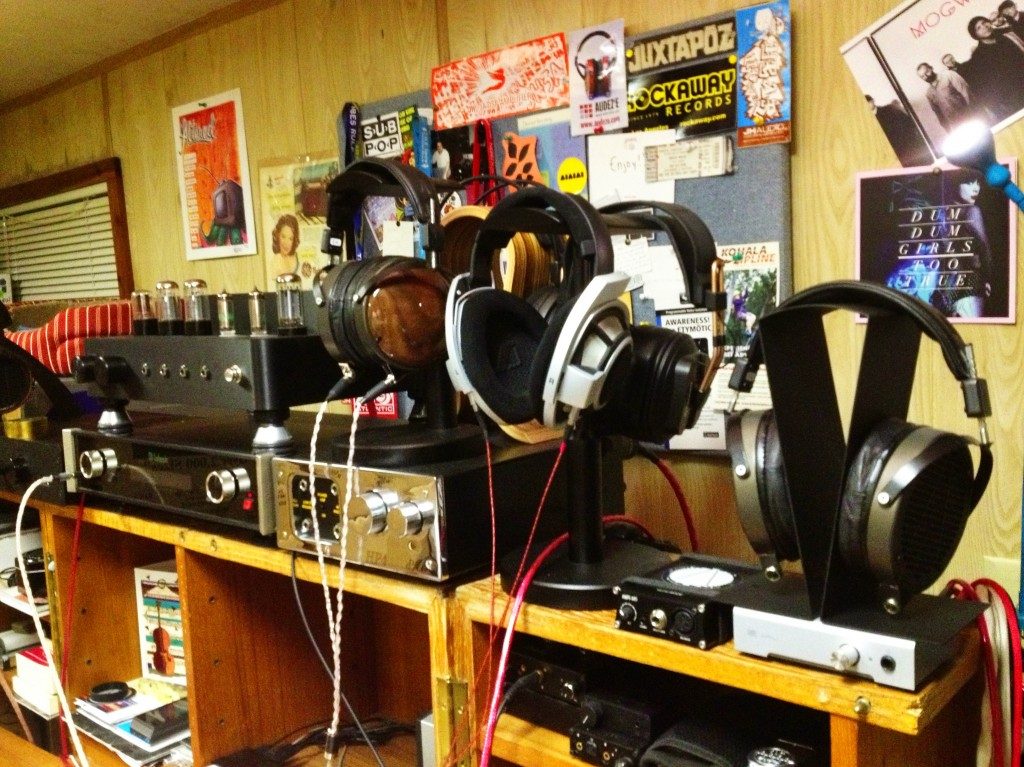
Admittedly, everything started to change for me years ago with the then prized music reproduction device for a teenager: A proper Discman coated in some ridiculously loud color (yellow), screaming “I’m water-proof”, with 8X over-sampling and lil’ springs and rubber gaskets to keep the disc from skipping while you banged it around. Because we were able to connect our own Discman to a stereo using an RCA-to-3.5mm“mini” cable, we were able to jam along to our own tunes on our friends’ parents systems (Kef loudspeakers, in my case). Our parents were raised on speaker systems while our generation and the generations after us were raised on headphones. So my migration over to the high end of personal audio makes sense now that I look back at my experiences.
The majority of todays’ parents don’t own big stereo systems in their homes. Even the average in-room system seems to have shrunk. And it’s getting harder to find actual stereo components today, save the few remaining brick-n-mortar Hi-fi shops and some at the big box stores (nothing of great quality there). But headphones are everywhere! From five-dollar Skullcandy IEMs and expensive Sennheisers at Guitar Center to the “lifestyle” stores like Brookstone andUrban Outfitters. Shit, headphones are stacked in the impulse-buy section at WalMart and other megastores. You can grab a pair of Sony IEMs at a gas station minimart that’ll probably beat the pants of you stock Apple ear-buds. You know what that means? It means us music addicts and seekers of great sound finally have a common denominator with the average consumer! Hobbyists from any walk of the high fidelity life have something in common with the average customer today because headphones are a part of their everyday lives, whether they love music or not. And this is epic.
People walk around with ear-buds or cans as a means of communication. Sure, not everybody, but a huge portion of the consumer-electronics sales on a global level for the past few years have been headphone-related products. That’s a key element in the decline in the high-end stereo world. Once you have a perceivable impact on the day-to-day life of your tribe, you will continue to succeed and grow.
Seriously: The crazy thing is many people forget, during these day-to-day lives that I’m referring to, that headphones or ear-buds actually play an integral part in their lives every single day. However, they have a profound mental lock on that experience because they’re engaged in it so often – when you jar them loose, even if only for a minute, from what they’re accustomed too hearing, even if all you do is present a clean musical presentation (which will have much lower harmonic distortion than their used to hearing through their lil’ plastic ear-phones) they have a much greater chance of reacting to that – relatively speaking – than playing them a $30K in-room stereo reference system. Not to mention the price-tag difference. I don’t even think comparisons are even necessary. Between the entry-level cost of state-of-the-art personal fidelity and high end audio for the home the spread is as vast as the divide between the insanely rich and the rest of us. Not to mention, living spaces are getting smaller as apartments get smaller. So, want to play music loud without disturbing your neighbor or your sleeping family members? Toss on your cans.
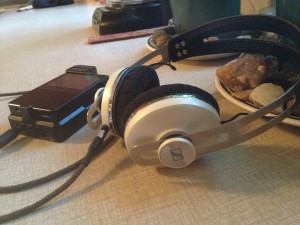
Reaching beyond the territory I covered earlier in my What is the Future of the High End series essays for Positive-Feedback, I realize I was half-right when I called Personal Audio “The Audible Gateway Drug” to high end stereo systems. It can be exactly that, of course, and I still believe you have more possible Hi-fi converts in the headphone hobbyist community than anywhere else. But it’s also true that a majority of those hobbyists and music addicts won’t move to in-room stereo systems. And that’s OK. It’s still good for the audio community as a whole. I may have been, in my previous essays, too confident, or merely overly excited, and therefore irrationally optimistic that more Head-Fiers (as in members of Head-Fi.org – the headphone community website, or perhaps, simply a headphone devotee) would jump into high end stereo after getting a “taste” of great sound with headphones. I know saying that was partly the result of ignorance with regard to the edge of the personal audio arts at the time, but perhaps the quality of personal audio reproduction continued to improve. Frankly, I don’t give a shit either way. The bottom line is that headphone listeners don’t merely get a “taste” of the sonic pie anymore – they can achieve the same transcendental listening experience with headphones as with a two-channel in-room system. I know that I have had the same extremely surreal experience with both. So why can’t you?
I’m often asked: “Do you really think you can experience the same thing with cans”? C’mon, it’s second-rate”. I truly wish I could sit these doubters at my ever-changing state-of-the-art headphone rig. I’m hearing things that I’ve never heard before with my reference albums. The music itself is still what drives it all, but with the loss of cool artwork to check out while listening to a new album, we’ve lost another level of connection with the artists – hearing new stuff in a record you’ve listened to literally a hundred times in your life makes the whole experience new again. That’s what higher fidelity can do for you. Now, what could possibly be wrong with that? (Check out this thread on Audio360 HERE for more on this topic).
When I want to listen to new music and truly lose myself, when I want to let it all go in a meditative attempt to temporarily leave this stress-inducing anxiety ridden life, I reach for my Audeze cans. I used to get a new record and say, “man, I gotta hear this on the stereo”. Now I can’t wait to hear it on my headphones. That’s a true sea change. There were so many technical limitations to overcome in headphone audio years ago, though it’s undeniably the cleanest and fastest conduit to your ears and your soul. One ultimate goal in the high-fidelity in-room system experience was, for me and many people I know, to break down everything between us and the transducer, whether it was electrostatic or planar magnetic, dynamic driver-based, or something completely alien at the time. It was crucial to address the room (ADR – adsorb, diffuse, reflect) with acoustic treatment, loudspeaker placement, all of that stuff, but with headphones, we don’t have to deal with it (well, that’s arguable, but it’s no where close to as important as the problems that arise with in-room stereo systems).
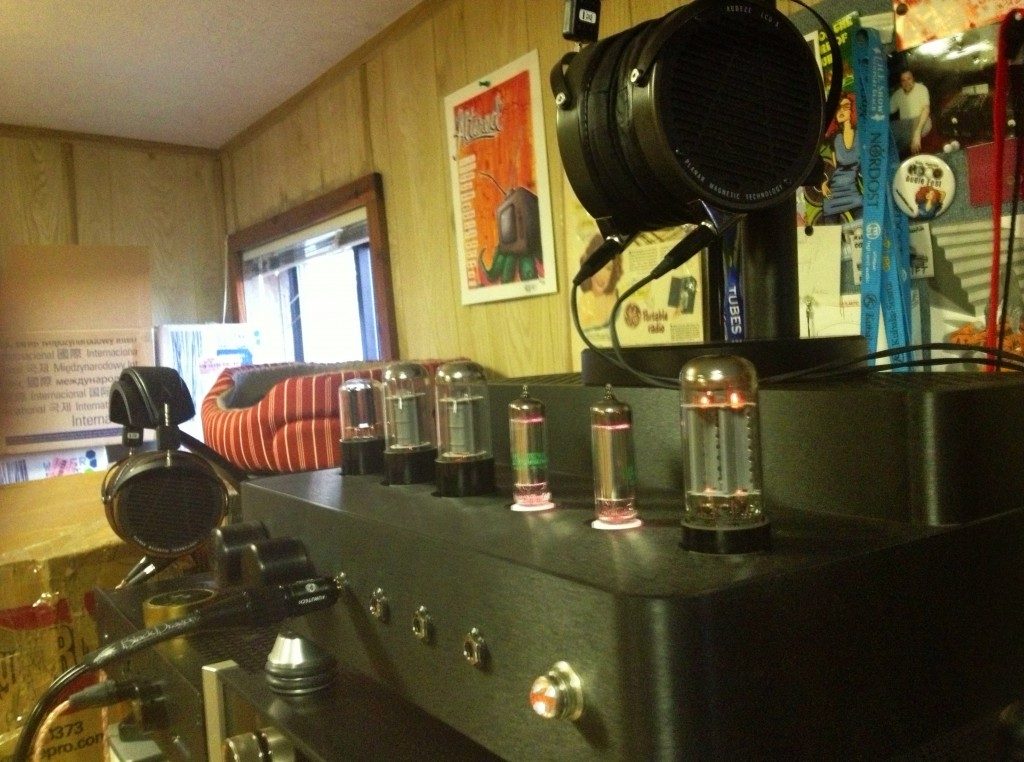
There have been other acoustic issues to address throughout most of personal audio’s evolution that almost worked against the developers. It’s human beings imbibing this stuff. It’s not dummy testing heads or anything connected in an anechoic chamber. It is not measurements and test tones. It’s something you just can’t quantify or measure – it’s the human emotional connection. Personal, portable, DAP (digital audio player)-inspired, headphone-related audio is in the midst of a renaissance. As I stated, along with Warren Chi, in our mission statement over at Audio360.org:
“Music is everywhere. It comes at us from 360·, surrounding us. It fills the void between us all. It binds us together and keeps us from falling apart. It flows between us – from one to another – as it carries our thoughts and feelings, sharing our hopes and dreams with one another. It renews us, gives us life. It has a life of its own to give. Music lives. It never dies.
Audio360.org believes that we are at the precipice of the golden age of personal and portable high-fidelity. We also believe this evolution in audio will bring us closer to the music. We aim to chronicle this paradigm shift with impassioned, experienced ears; eager pens, hopeful hearts, and open minds. Featuring breaking news, dual-viewpoint reviews, key-player interviews, insightful and colorful columns, and an open syndication policy.”
-Audio360.org Staff
What I actually find most enjoyable about personal audio has little to do with the gear.
Sure, geeking-out with a bunch of headphone hobbyists is awesome (many a sleepless night with my friends Warren Chi and Stan Ahn at the old Sonic Satori Personal Audio Lab in Pasadena, SoCal). There’s a natural social component to personal audio that has roots firmly planted in the great age of the cassette mixtape. It’s interesting, there’s a real connectedness at play here: My generation – Generation X/90’s kids, and even the 80’s generation before us –became not only familiar with the concept of taking our tunes with us, but the cassette tape introduced a wondrous social component to our musical experience. As a bedroom DJ first and foremost, I always put my whole heart into a good compilation/playlist. That phenomenon, fantastically presented in High Fidelity is the best fix for a music addict. Music, for me at least, is positive, providing a sense of balance and a groove in my step. It can easily enhance or take away my pain. It all depends on the mood I’m in. But I remember some of my favorite mixtapes like it was yesterday, given and received (don’t you?). Then the CDR came out and we could burn a CD playlist at Red-book CD-quality (44.1kHz/16-bit), which is hardly recognized anymore (for another column – but many people haven’t even heard 44.1/16-bit done well). Man it felt good sliding the disc into the CD tray while getting’ ready to get down. Seriously, you know you made a mixtape to make love to. Didn’t we all? Yes, of course.
The personal audio community also seems to be a far more modern music-oriented than the audiophile community. So as the technology grows, so does my obsession with music! Look – there’s actually a way to cut through all of this (and maybe you put the article down after reading this sentence), but I feel obligated to say it: For me, the quality brings the fun back into the whole music playback experience!
In addition to this positively-reinforcing, nostalgia-based portion of personal audio, a particular aspect of the experience came with a pretty big negative too, especially when it came to home-based headphone systems: They were usually a part of a receiver or integrated with a headphone output, so it was solitary. Many products followed that limited view back then. And, now, with all three of my favorite reference headphone amplifiers capable of feeding at least three channels simultaneously (up to three headphones): Cavalli Audios’ Liquid Gold differential solid-state amplifier, ALOs’ Studio Six tube amp, and the classic, E.A.R HP4 tube headphone amp; it doesn’t have to be a solitary event anymore. Hell, Sennheiser’s throwing silent raves everywhere, where each attendee wears a set of wireless headphones and hears the DJ spin via a closed WiFi hotspot.This collective is silent to the naked ear, but clear as a bell through Sennheiser-wearing ravers, bumpin’ together like a club around everyone, rockin’ the headphones! My wifey Alexandra and I had a few of our own private silent raves in the Sonic Satori Personal Audio Lab!
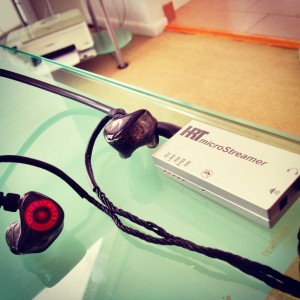
The innovation that’s happening everywhere in personal audio today is also astounding (yet another topic for a future column). I’m not kidding when I say that while sitting on a plane from Northern California to Washington D.C. Weeks ago I had one of the most incredible listening sessions I’ve had in many a year. Admittedly, it could’ve also been the Xanax that I now find necessary for taking off and landing, but listening to loud music calms me, I don’t know why. Sometimes it blows my mind, how loud it can get without distorting, especially using the new JH Audio Roxanne’s (check out my review at Head-Fi.org). Don’t fret Alexandra – I don’t crank the loud tunes for too long!
It boggles my brain to see how far the headphone market has grown. Alex Rosson, CEO for Audeze headphones, appeared on Bloomberg television months ago as they announced the “high end headphones” market has exceeded 2 billion dollars, I believe (or four billion, I honestly can’t remember). So, if you’re in the hi-fi industry on the retail side or the manufacturing end, this growth is something you should take advantage of. Either that, or pack it up.
Because headphones and ear-buds are such an everyday part of many people’s lives, it makes the demonstration of the virtues of high-fidelity so much easier to discuss. People are already intimately connected to a part of the signal chain (headphones/iPhone), so it’s much easier for them to grasp the difference in quality. When someone enters your store with an iPhone in his hand as his main music transport, all you need to do is find out their musical tastes in order to be able to make an informed decision on which headphones they might find interesting. Imagine trying to manipulate that guy to a large two-channel system sale instead of the headphones they are interested in. Money will just be walking out the door. Provide a colorful headphone display in the window of your store and just see if more people walk-in. If you are located in a city, near a train station, or even a commuter rail, I think it’ll be obvious.
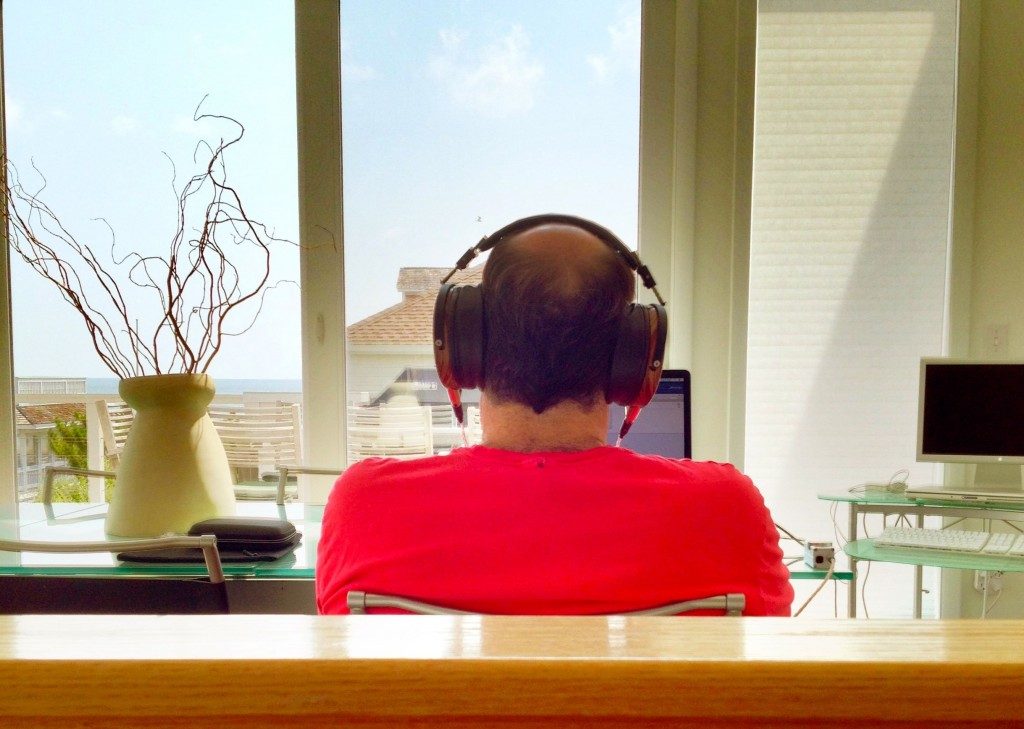
It comes down to making a connection, a real, sincere, human connection to a new would-be enthusiast. That’s all there is to it in this increasingly digital age. Real human connections are a surprisingly cool and rare experience these days. If you can make someone smile and get them excited about better sound, that’s a huge step for everybody.
When music washes over me, when the sound is delivered through such a clean signal path, in a way that sounds almost analogous (with such low distortion) to the real thing, and when executed properly, is something I can truly feel (whether the actual sound waves are physically touching my body or not). I hear music in such a richer, more immediate, more detail-oriented way. I hear it in a way that renders itself lifelike because it’s believable. This is why I have a passion for great-sounding audio gear. It makes the music real.
Sometimes all I can do is just shake my head in disbelief while listening to my music collection on my favorite cans. Whether that’s Audeze, Sennheiser, or JH Audio (amongst others), I get my mind blown daily at the insanely fresh sounds these personal audio systems produce. (Of course, much of that is owed to the amp, the source, decoding engine and cables along with the headphones and the recording itself.) I even burst-out laughing spontaneously while listening to my headphones at home or on-the-go. I can’t help it. I’m like, “damn, that’s strong”. It hits me right in my gut. I live for that feeling. Meanwhile, I’m laughing at how ridiculously amazing it sounds. On my favorite systems, there’s so much velocity behind the transient attack, especially when playing something like Aphex Twin, Burial, or Alix Perez, that it simply floors me with it’s clarity. The same goes for the uber-silky mids and pounding bottom-end of Boards of Canada, Bonobo, Daft Punk, and artists like Hecq and Recondite. Besides being consistently wowed by the sound of my personal audio components, I get even more floored by the music it gives me.
I suggest you get on-board. Sure, the vinyl explosion has been amazing. It’s also re-awakened the interest on great sound. I personally love listening to LPs on my headphone system. But take a chance if this all seems alien to you. Hey, you might even enjoy yourself and your music again! As for me: I’m rockin’ one of my reference headphone systems as I type these words. The most important thing is the Listening. That’s the bottom-line. Just look around and you will notice that personal audio isn’t going anywhere. It’s rapidly progressing. Purchase your ticket and take the ride. All I know is that I’m having fun and hearing amazing stuff. Sure, it sucks…
To be continued…
Associated Gear
(Used while writing):
*Audeze LCD-2 w/ Fazor technology
*Double Helix Cables Complement3 dual-XLR headphone cables
*Cavalli Audio Liquid Gold differential solid-state headphone amp
*McIntosh D100 DAC/digital line-stage. Headphone amplifier
*MacBook Pro Retina running Amarra Symphony 3.0.2 playback software
*Unison Research Simply Phono tube stage
*VPI Traveler turntable w/ Ortofon 2Mblue cartridge
*Analog front-end wired with all Black Cat Cable
* Digital front-end wired with all Nordost Heimdall2 signal and power cables, with all QRT/Quantum power underneath the whole system














Reply
Want to join discussion?
Feel free to contribute!